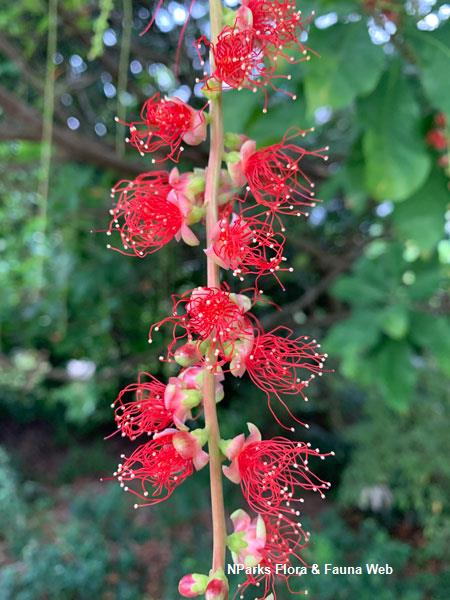
Back
Barringtonia acutangula (L.) Gaertn.
| Family Name: | Lecythidaceae |
| Synonyms: | Barringtonia spicata, Eugenia acutangula |
| Common Name: | Indian Putat, Freshwater Mangrove, Red Barringtonia, Stream Barringtonia, Indian Oak, Itchy Tree, Itchy Bush, Wild Almond, Kandu Almond |
Barringtonia acutangula, also known as Indian Putat, has pendulous flowering stalks which are as long as an arm's length. Each stalk contains up to 75 flowers which are night-blooming. Small yet showy, these flowers are scarlet red with filamentous stamens. Fruit is small and buoyant which is well adapted for water dispersal.
Name
Classifications and Characteristics
| Plant Division | Angiosperms (Flowering Seed Plants) |
|---|---|
| Plant Growth Form | Tree (Small (6m-15m)) |
| Lifespan (in Singapore) | Perennial |
| Mode of Nutrition | Autotrophic |
| Plant Shape | Vase, Open |
| Maximum Height | 15 m |
Biogeography
| Native Distribution | Afghanistan, Pakistan, India, Bangladesh, Myanmar, Laos, Cambodia, Vietnam, Thailand, Malaysia, the Philippines through Malesia to New Guinea and Northern Australia. |
|---|---|
| Native Habitat | Terrestrial (Monsoon Forest, Riverine) |
| Preferred Climate Zone | Tropical, Sub-Tropical / Monsoonal |
Description and Ethnobotany
| Growth Form | It is a shrub or small semi-deciduous tree, usually 2 - 13 (-25) m tall and often produces multiple stems. Bark is fissured and grey. |
|---|---|
| Foliage | Leaves is elliptic to obovate-oblong (6 - 16 (-22) cm long and 2 - 8 cm wide). They are leathery and mostly smooth. The leaf margin is finely toothed and petiole is short (0.4-1.5 cm long). Cataphylls are triangular to linear. The leaves may partially shed during extended dry periods. |
| Flowers | inflorescence are pendulous racemes, 20 - 45 (-78) cm long and densely covered with up to 75 flowers. Flowers are scarlet red, small yet showy. Each flower have 4 - 5 petals and numerous filamentous stamens that are deep pink to red. Flowers are observed to be mildly-fragrant and night-blooming (opening at sunset and aborting by daybreak). The tree blooms periodically throughout the year. |
| Fruit | Fruit is 4-angled or ovoid and corky with spongy interior which allows it to float and dispersed by water. Each fruit is 2 to 6 cm long and 1 - 3 cm wide, and contains 1 seed within. |
| Habitat | Distributed along riverbanks and lakes in evergreen and deciduous forests, as well as on seasonally-inundated floodplains and freshwater wetlands. |
| Associated Fauna | Flower nectar attracts bats, moths, and birds like honeyeaters and lorikeets. Euproctis lutea (Yellow Tussock Moth) lays eggs on sheltered undersides of leaves, and the hairy black caterpillars feed on the fruits. Caterpillars' ability to cause severe skin irritation or rash gives rise to tree's common names like Itchy Tree and Itchy Bush. |
| Cultivation | Hardy tree, able to sprout from stumps and even fallen twigs. Tolerant of waterlogging and wide range of soils, including heavy clay. Propagate by seeds and stem cuttings. |
| Etymology | Genus epithet 'Barringtonia' named after Daines Barrington (1727-1800), English lawyer, antiquary and naturalist. Species epithet 'acutangula' means 'having sharply-pointed angles', a reference to the tree's ribbed fruits. |
| Ethnobotanical Uses | Edible Plant Parts : Edible Leaves Food (Herb or Spice) (Fruit or Vegetable): Young leaves are reportedly edible and consumed as vegetable in Mekong River Basin region Others: Medicinal: Various parts of plant used in Ayurvedic medicine. Roots are cooling and used to relieve fever. Bitter-tasting leaves used to treat diarrhoea and indigestion. Seeds rubbed over chest or eaten with ginger to induce vomiting and expel respiratory mucus. Also used as general health tonic to relieve bodily weakness, improve blood circulation and regulate menstrual cycle. Bark used by Aboriginals as painkiller. Bark is also anti-microbial, and boiled in water, which is drunk to treat skin infections. Products: Saponin-rich leaves and bark pounded and used to deoxygenate water for the purpose of stunning fish, which can then be easily caught. Culture: Australian aborigines use blooming season as signal to hunt for freshwater mussels. Flowers used by the Kaumaras (a Hindu sect) in the worship of Lord Muruga. |
Landscaping Features
| Desirable Plant Features | Ornamental Flowers, Fragrant (Flowers) (Night, Dawn / Dusk, Day), Ornamental Fruits |
|---|---|
| Landscape Uses | General, Riverine |
| Thematic Landscaping | Water Garden, Naturalistic Garden |
| Usage Hazard - Cons Remarks | May be colonized by caterpillars of Euproctis lutea (Yellow Tussock Moth), whose irritant hairs can cause severe skin itch and rash. |
Fauna, Pollination and Dispersal
| Fauna Pollination Dispersal Associated Fauna | Bird-Attracting |
|---|---|
| Pollination Method(s) | Biotic (Fauna) (Insects (Bee), Insects (Butterfly, Moth), Vertebrates (Bird), Vertebrates (Bat)) |
| Seed or Spore Dispersal | Abiotic (Water) |
Plant Care and Propagation
| Light Preference | Full Sun |
|---|---|
| Water Preference | Moderate Water, Lots of Water |
| Plant Growth Rate | Moderate |
| Rootzone Tolerance | Fertile Loamy Soils, Waterlogged Soils (Drains Site), Drought Tolerant |
| Maintenance Requirements | Moderate |
| Propagation Method | Seed, Stem Cutting |
Foliar
| Foliage Retention | Drought / Semi-Deciduous |
|---|---|
| Mature Foliage Colour(s) | Green |
| Mature Foliage Texture(s) | Smooth, Glossy / Shiny, Thick |
| Prominent Young Flush Colour(s) | Red |
| Foliar Type | Simple / Unifoliate |
| Foliar Arrangement Along Stem | Alternate |
| Foliar Shape(s) | Non-Palm Foliage (Obovate) |
| Foliar Venation | Pinnate / Net |
| Foliar Margin | Entire - Wavy / Undulate, Dentate |
| Foliar Apex - Tip | Acute |
| Foliar Base | Cuneate |
| Typical Foliar Area | Notophyll ( 20.25cm2 - 45 cm2 ) |
| Leaf Area Index (LAI) for Green Plot Ratio | 3.0 (Tree - Intermediate Canopy) |
Non - Foliar and Storage
| Trunk Type (Non Palm) | Woody |
|---|---|
| Bark Colour(s) | Grey |
| Mature Bark Texture | Fissured |
| Stem Type & Modification | Woody |
| Root Type | Underground (Tap Root, Fibrous Root) |
Floral (Angiosperm)
| Flower & Plant Sexuality | Bisexual Flowers |
| Flower Colour(s) | Red |
|---|---|
| Inflorescence Type | Raceme |
| Ovary Position | Inferior / Epipgynous |
| Flowering Opening Time | Night (dusk to dawn) |
| Flower Lifespan on Plant | 1 Night |
| Flowering Habit | Polycarpic |
| Flowering Period Remarks | Periodically throughout year in Singapore |
Fruit, Seed and Spore
| Mature Fruit Colour(s) | Brown |
|---|---|
| Fruit Classification | Simple Fruit |
| Fruit Type | Dehiscent Dry Fruit , Capsule |
Image Repository
Others
| Master ID | 1450 |
|---|---|
| Species ID | 2743 |
| Flora Disclaimer | The information in this website has been compiled from reliable sources, such as reference works on medicinal plants. It is not a substitute for medical advice or treatment and NParks does not purport to provide any medical advice. Readers should always consult his/her physician before using or consuming a plant for medicinal purposes. |


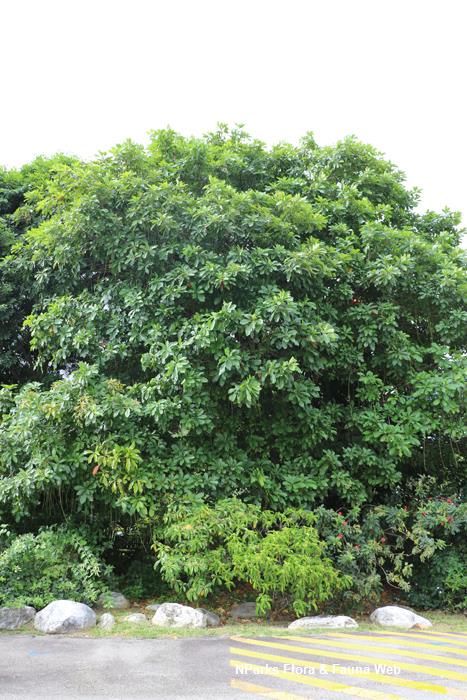
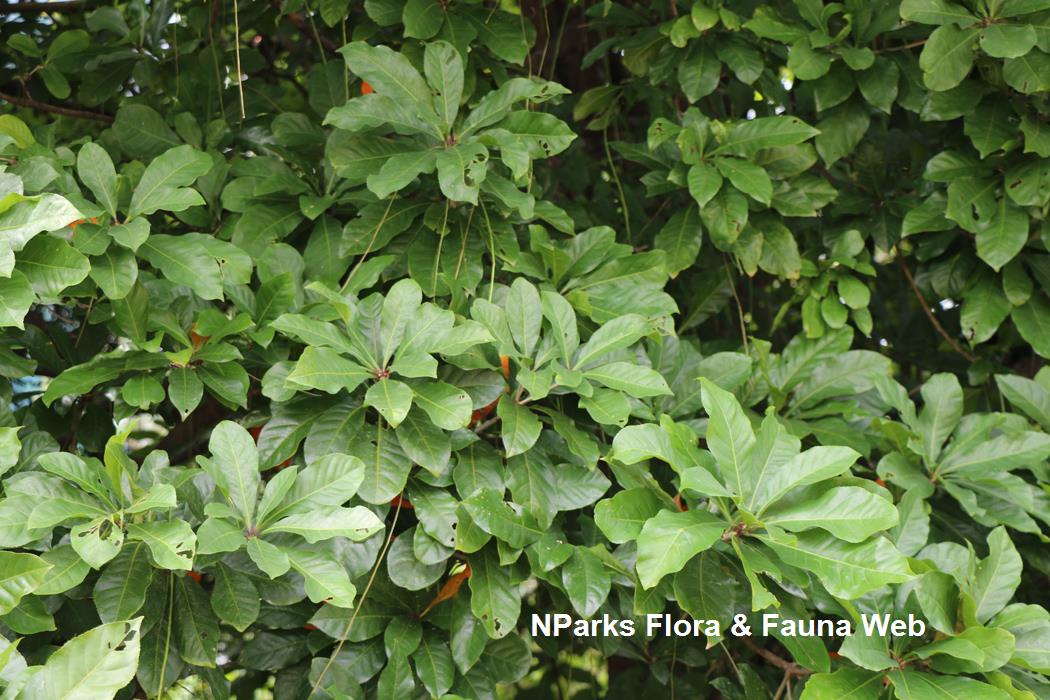
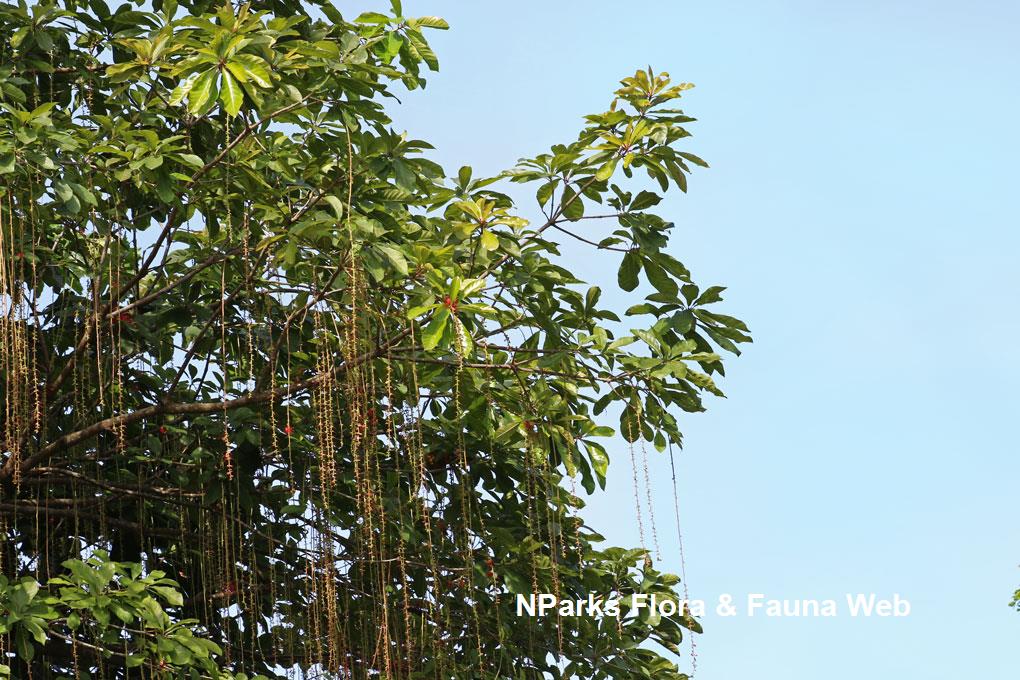

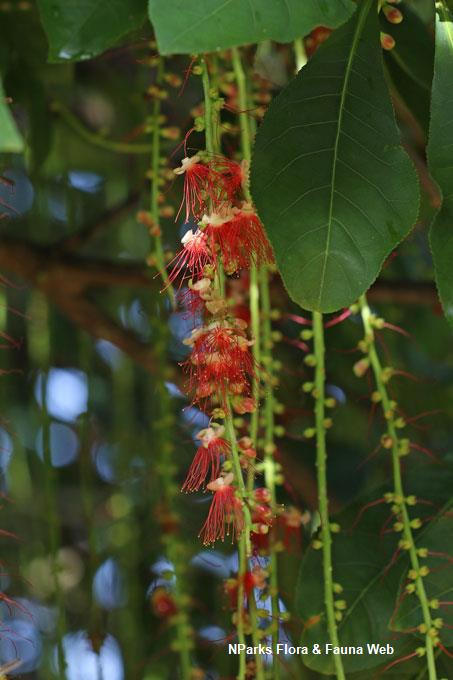
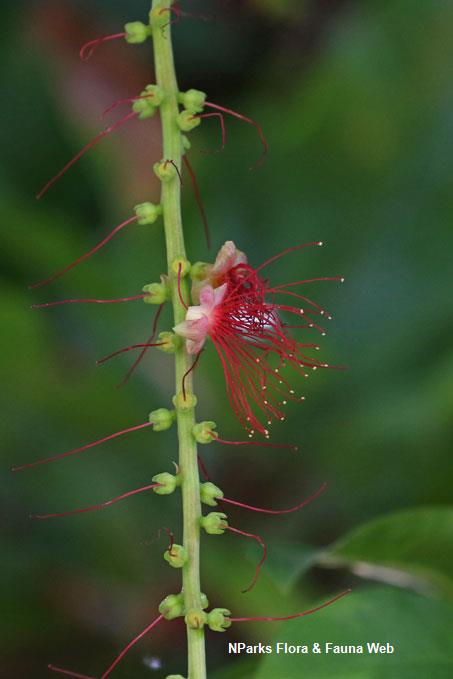














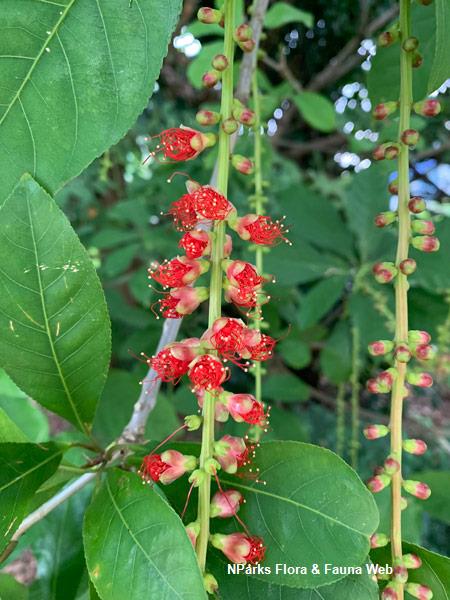
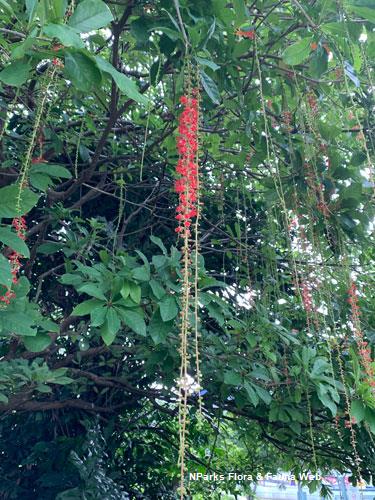
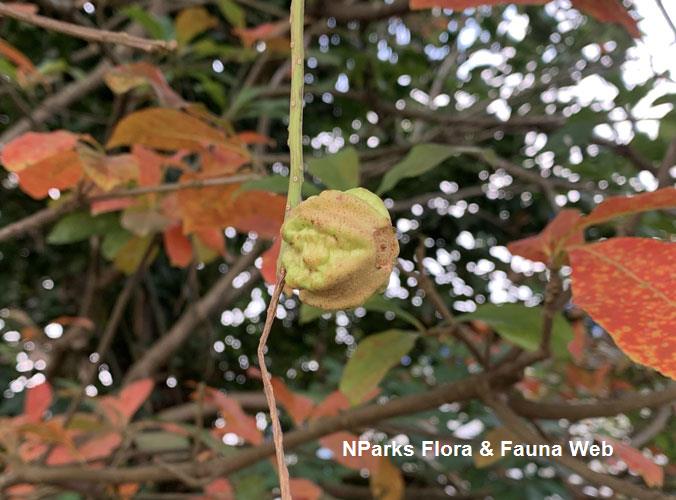

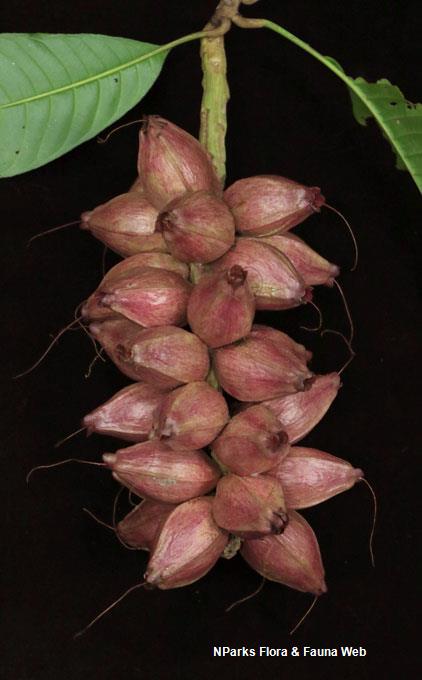
_lowres.jpg)
